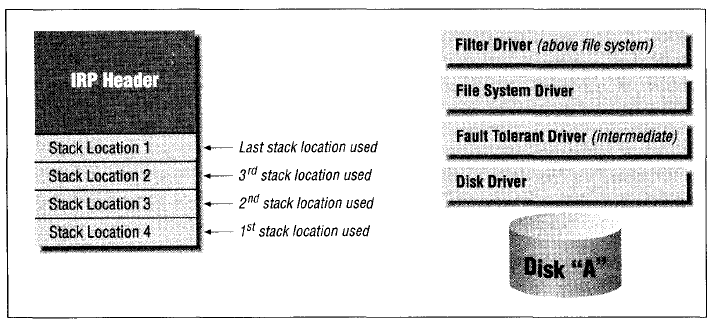学而时习之,不亦悦乎?
这次记下的时IO_STACK_LOACTION的东东,以前就知道用,一直很迷糊,现在终于搞通了,爽!
还发现一个秘密,微软的Win2K源代码真是好东西啊,可惜放在我硬盘上的宝贝被浪费这么长时间。
IO_STACK_LOCATION和它的名字一样,是一个类似于栈的结构,属于先进后出的结构,看下面的例子 :

如上面的图所示,I/O管理器想文件系统驱动发送一个读请求,I/O管理器在创建IRP时候就分配了4个IO_STACK_LOCATION单元,这些单元是反向使用的。
当I/O管理器在调用驱动时,它总是讲IRP的StackLocation指针指向下一个StackLocation;当被调用的驱动释放IRP时,Stack Location真正被指回到前一个Stack Location。因此当过滤驱动的派遣函数运行时,I/O管理器使用Stack Location #4,也就是分配的最后一个Stack Location。
NT I/O管理器将IRP头中的StackCount字段初始化为IRP中Stack Location的总数。IRP头中的CurrentLocation字段初始化为StackCount+1,每一次通过IoCallDriver()调用驱动的派遣函数时,这个值减1。
因此,图中的StackCount=4,CurrentLocation初始化为5,实际上这个值是一个无效的指针值。那为什么要将CurrentLocation初始化为5呢?这得从I/O管理器调用器层次化调用驱动的过程讲起:内核组件总是首先得到指向下一个Stack Location的指针,然后在该Stack Location中填写相关的参数,再进行IoCallDriver();
当I/O管理器将IRP发往驱动堆栈中的最上面的驱动时,它的下一个Stack Location值为CurrentStackLocation-1=4,这个值时正确的!
I/O管理器经常检查一些IO_STACK_LOCATION中的相关值,例如在IOCallDriver()中,I/O管理器首先将CurrentLocation减1,然后检查CurrentLocation的值是否小于等于0,如果该值小于等于0,表明IoCallDriver()调用的次数多于Stack Location,I/O管理器将执行BugCheck,错误代码为NO_MORE_IRP_STACK_LOCATIONS。
上面几点可以从Win2K的源代码中看出:
Win2K中IoCallDriver代码的调用顺序是这样的:
NTSTATUS
IoCallDriver(
IN PDEVICE_OBJECT DeviceObject,
IN OUT PIRP Irp
)
{
return IofCallDriver (DeviceObject, Irp);
}
NTSTATUS
FASTCALL
IofCallDriver(
IN PDEVICE_OBJECT DeviceObject,
IN OUT PIRP Irp
)
{
//
// This routine will either jump immediately to IopfCallDriver, or rather
// IovCallDriver.
//
return pIofCallDriver(DeviceObject, Irp);
}
NTSTATUS
FASTCALL
IopfCallDriver(
IN PDEVICE_OBJECT DeviceObject,
IN OUT PIRP Irp
)
/*++
Routine Description:
This routine is invoked to pass an I/O Request Packet (IRP) to another
driver at its dispatch routine.
Arguments:
DeviceObject - Pointer to device object to which the IRP should be passed.
Irp - Pointer to IRP for request.
Return Value:
Return status from driver's dispatch routine.
--*/
{
PIO_STACK_LOCATION irpSp;
PDRIVER_OBJECT driverObject;
NTSTATUS status;
//
// Ensure that this is really an I/O Request Packet.
//
ASSERT( Irp->Type == IO_TYPE_IRP );
//
// Update the IRP stack to point to the next location.
//
Irp->CurrentLocation--;
if (Irp->CurrentLocation <= 0) {
KeBugCheckEx( NO_MORE_IRP_STACK_LOCATIONS, (ULONG_PTR) Irp, 0, 0, 0 );
}
irpSp = IoGetNextIrpStackLocation( Irp );
Irp->Tail.Overlay.CurrentStackLocation = irpSp;
//
// Save a pointer to the device object for this request so that it can
// be used later in completion.
//
irpSp->DeviceObject = DeviceObject;
//
// Invoke the driver at its dispatch routine entry point.
//
driverObject = DeviceObject->DriverObject;
PERFINFO_DRIVER_MAJORFUNCTION_CALL(Irp, irpSp, driverObject);
status = driverObject->MajorFunction[irpSp->MajorFunction]( DeviceObject,
Irp );
PERFINFO_DRIVER_MAJORFUNCTION_RETURN(Irp, irpSp, driverObject);
return status;
}
微软的代码写的就是清楚,值得学习,呵呵
下一讲将讲述IoCompleteRequest()的学习笔记,结合Win2K源代码学习,呵呵






















 6076
6076

 被折叠的 条评论
为什么被折叠?
被折叠的 条评论
为什么被折叠?








